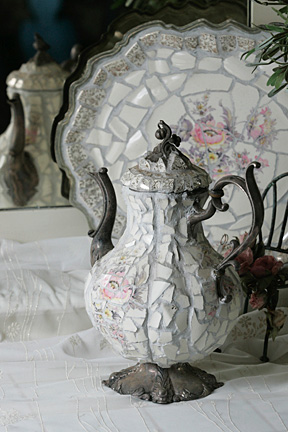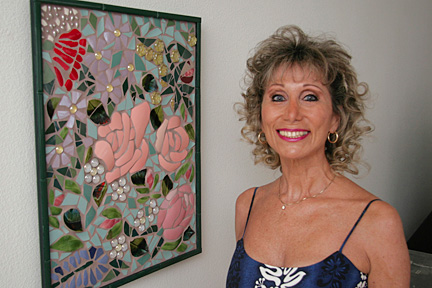 |
Mosaic magic
A class teaches how to
turn shattered pieces into
works of art
Susan Valle has a reputation for breaking dishes. Her friends never buy her antiques for her birthday. In fact, they don't buy anything fragile. "Not unless it comes with a promise not to break the item," she laughed.
Mosaic ArtBeginning classes: 6 to 9 p.m. Wednesdays, next week through Sept. 28Place: Wahiawa Community School, Leilehua High School Cost: $30; plus $35 supply fee Call: 622-1634
|
In fact, when she decided to mosaic an entire stairway in her home, she used a big tin of her grandmother's old buttons to embellish the pattern. "People don't need to get mad if something special breaks; you can re-create it and bring it back to life in the form of something else."
Mosaic art has a long history, she said. "It's an ancient form of art and it has been around forever." In 600 B.C., the Greeks were using colored pebbles, turning to shards of glass and tiles in 300 B.C. "Although it is an ancient form of art, its popularity is resurfacing."
Valle, who considers mosaic the "ultimate recycling art," teaches classes at the Wahiawa Community School for Adults a couple of times a year. The next session starts Wednesday. If you plan to attend, she has a few warnings.
"You definitely get cut handling all of the sharp edges. And don't get your nails done ... it takes such a toll on your hands."
Anyone can mosaic once they learn the basics, she said. One of the first things you do in class is break things using a hammer, which makes some people a little uncomfortable and hesitant, at least in the beginning.
"For most people it is unnatural to break something new on purpose," Valle said.
The first class is mainly used for finding inspiration and coming up with a design, from an abstract pattern to a picture. A picture can be drawn or traced on your base -- anything from a tabletop to a planter box -- to serve as a pattern, she said.
"Lots of couples come to class together. Their pieces come out completely different in the end. The workshop is meant to draw upon creativity."
Initial cost is minimal, Valle said. She provides all the materials, including tile nippers, hammers, tile adhesive and grout, and tiles or china. Students just need to bring an object to mosaic.
"The 2-in-1 tile adhesive and grout is easy to use and can be found at any hardware store. The grout comes in hundreds of colors with a smooth or sanded finish. Black can give projects a stained-glass effect."
Valle has dappled in painting and scrapbooking, but said, "Mosaic is my passion."

The teapot and tray are the result of one of Susan Valle's mosaic techniques of breaking dishes and piecing them back together.
For her students, Valle suggests bringing a base item that can be finished over the five-week session.
"The process is similar to quilting or doing a puzzle," she said. "You do a little bit at a time. It's time-consuming and therapeutic at the same time."
her first project was to cover some old Formica tile that served as a backsplash around her kitchen sink. She started with a small patch, and things took off from there. "It is so rock solid and durable and easy to clean with a scrub brush."
Now she has mirrors, platters, tables, stairways, birdbaths, steppingstones and more. One of her largest projects was a main staircase in her home. "It took me a year to complete. I did one stair at a time."
She suggests steppingstones and picture frames as good choices for newcomers. Inexpensive serving trays are also good, as the recess areas around the edges serve as a border, making it easier to place the tiles.
Valle shops at various Ross' stores for single pieces of matching china. She looks for Victorian patterns, floral and feminine.
At garage sales and thrift stores, she'll search out many of the items that she uses for bases. Among her finds are a "totally trashed table that nobody would think of buying and bring home," a tea cart and mirrors.
"My husband doesn't like me bringing home big pieces of furniture. I have to hold myself back form buying items until the others are finished."

Patricia Nishimura learned the art of mosaic from Susan Valle and created this wall hanging.
Patricia Nishimura, a former student, took that advice, creating a large wall hanging that she'll be able to take with her when she moves.
"My first mosaic came out to be a masterpiece," she said. "With the knowledge I gained from class, I'm very comfortable working on anything. The class was a bright spot in my day."
Nishimura was not satisfied with ordinary china and tiles. "The colors are limited. I went to a thrift store and bought a '70s-style lamp for $3.99 and took a hammer to it," she said. "I was able to use a bowl, so the rose petals (in the wall hanging) curve outwards and the leaves turn inward."
The best part of mosaic work? "It's forgiving," Nishimura said. "If you put something down and don't like it, just pry it up and put something else in its place."
Kathy Allman also attended classes in the spring, creating a small table with a windmill theme. Allman is fascinated by the color variations and patterns that can be created using regular stones. "It was so surprising -- everything turned out so wonderful," she said.
Once the basics are learned, an array of items can be used to enhance the look of pieces. Costume jewelry adds flair, Valle said. "There is a lot of stuff you'd never wear but would add embellishment."
The possibilities are endless, from coffee tables, platters and serving trays to pitchers, walls, stairs or floors, she said. "Tiles can even be personalized to create meaningful gifts."
E-mail to Features Desk
[News] [Business] [Features] [Sports] [Editorial] [Do It Electric!]
[Classified Ads] [Search] [Subscribe] [Info] [Letter to Editor]
[Feedback]
